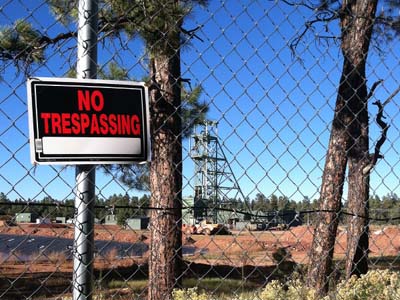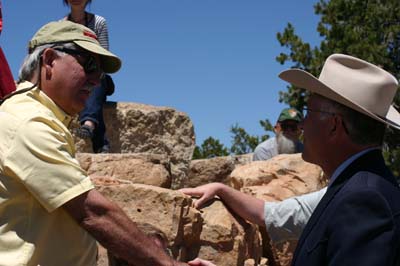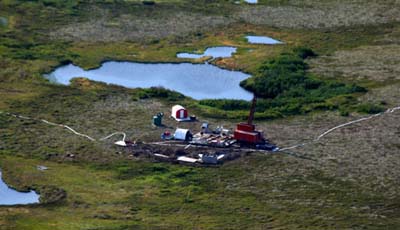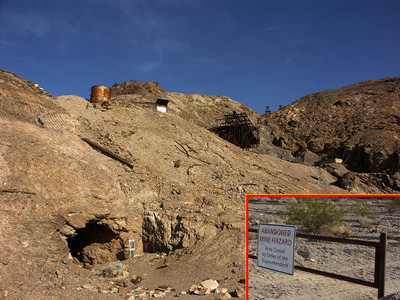
Mining threatens park wildlife, water, air
Mining poses serious threats to national parks.
Although no longer permitted inside park borders, existing mines near and around national parks threaten wildlife, damage water quality and induce air pollution.
One of the most prominent issues today deals with uranium mines that surround the Grand Canyon.
| Click on the video at the right to view an audio slideshow about mining in national parks narrated and prepared by writer Melissa Mallin |
In the one million acres surrounding Grand Canyon National Park in Northern Arizona, 3,000 uranium plains and four old mining sites cause serious contamination to the ground water surrounding the park. Watersheds are threatened from interconnected surface and groundwater systems, which extend miles beyond the park’s boundaries.
After speaking with the Grand Canyon Trust Program Director, Roger Clark, new mines threaten hundreds of springs and creeks, which offer valuable drinking water to thousands of species
On the Grand Canyon Trust website, Steve Martin, former superintendent of the Grand Canyon National Park, said, “Uranium is a special concern because it is both a toxic heavy metal and a source of radiation. I worry about uranium escaping into the local water because more than a third of the canyon’s species would be affected if water quality suffered.”
 |
The uranium Canyon Mine located about six miles southeast of the Tusayan Ranger District. The entire mine site is about 17 acres in size (Photo by Roger Clark, Program Director of Grand Central Trust). |
Uranium is a radioactive natural resource found in the Earth’s crust and seawater. When exposed to air, uranium ore forms uranium oxide that creates a yellow-brown powder called yellowcake. Wind, rain and other elements distribute the powder throughout the park which threatens both human and wildlife health.
“Evidence has linked contaminated water with uranium mining and contamination is well beyond safe for humans to drink. Every new mining operation sacrifices cultural sites and fragments wildlife habitat. These ponds attract animals that drink from the contaminated water which ultimately poisons and kills them,” said Clark.
Marc Fink, from the Center of Biodiversity, is most concerned with the potential for significant contamination of aquifers that are crucial for wildlife and adverse impacts to sacred lands of the Native American Tribes in the region.
| At right, Grand Canyon Trust Uranium Director Roger Clark greets then-Secretary of the Interior Ken Salazar (Photo Courtesy of Grand Canyon Trust). Below, advanced exploration work at the Pebble Mine consists of multiple core-drilling rigs (Photo by Anders Gustafson, courtesy of NPCA).
|
 |
In 2006, the increased price of uranium resulted in thousands of new mining claims within watersheds directly draining into the Grand Canyon and Colorado River. As prices began to decline in 2011, many of these sites were temporarily closed down or abandoned leaving behind hundreds of sites in need of cleanup
“There needs to be a rule change for what happens when they shut down mines. Generally, the 1872 mining law needs to be reformed as to require existing regulations to improve and reduce the likelihood of contamination such as putting up monitoring wells that can detect when contamination occurs. We are still recovering from the last uranium rush which poisoned so much water it’ll take generations to clean up,” added Clark.
In 1984, a flash flood contaminated Kanab Creek with high levels of uranium ore, which drains directly into the Grand Canyon. Currently, the Orphan Mine, Arizona1 Mine, the Canyon Mine and others contribute to the contamination.
On the Canyon’s South Rim, hikers are forbidden to drink from a permanently polluted spring located beneath an abandoned uranium mine. Visitors are advised not to drink from or bathe in many of the water supplies located within the park.
 In response to the increase in mining efforts, the then Secretary of the Interior Ken Salazar, ordered a 20-year ban on thousands of new mining claims that threatened to industrialize watersheds draining directly into the Grand Canyon and Colorado River.
In response to the increase in mining efforts, the then Secretary of the Interior Ken Salazar, ordered a 20-year ban on thousands of new mining claims that threatened to industrialize watersheds draining directly into the Grand Canyon and Colorado River.
In January 2012, Salazar succeeded in banning one million acres of public land in the Grand Canyon watershed from new mining claims and required that development on old claims have “valid existing rights” to mine.
The ban, along with several other legislations, such as the South Rim Litigation and Grand Canyon Watersheds Protection Act serve as successful milestones in the battle between miners and the park.
Though many organizations have succeeded in enacting legislation to prevent further mining issues, on-going threats still exist.
The Bureau of Land Management can still allow old mines to reopen without updating environmental reviews and owners of existing uranium mines can still reopen as uranium prices increase.
The Grand Canyon Trust, Sierra Club, and the Center for Biological Diversity are among few of the organizations actively fighting for legislation to ensure maximum protection for the entire Grand Canyon.
But, the Grand Canyon isn’t the only national park dealing with mining threats. Another major concern involves the future of the Pebble Mine that would affect parts of Bristol Bay near Lake Clark and Katmai National Parks and Preserves in Alaska.
Both Lake Clark and Katmai National parks protect a portion of the Bristol Bay watershed for the perpetuation of one of the last remaining sockeye salmon fisheries on Earth. Valued between $350-$500 billion, the pebble mine, if built, would become the largest open-pit mine in North America and could pollute areas in the Bristol Bay protected by the parks.
Nicholas Lund with the National Parks Conservation Association (NPCA) predicts that mining impacts at Lake Clark and Katmai parks could include impact on fisheries due to degraded air and water quality, habitat disturbance with displacement of wildlife and diminishment of visitor experience due to a loss of wilderness.
Currently the Environmental Protection Agency (EPA) is studying the Bristol Bay watershed to examine the impacts that mining could have on the regions water quality and salmon fishery. The report will guide the agency’s future actions and promote sustainable resource development in Bristol Bay.
 |
An administrative closure sign in 2008 when testing revealed high levels of lead and other contaminants in the soil at Keane Wonder Gold mine in Death Valley National Park. Signs are one of the ways parks can illustrate safety hazards and preventions (Photo courtesy of the National Park Service). |
Other issues involving mining in national parks relate to the Alton Coal Mine near Bryce Canyon National Park in Utah, coal mining in Big South Fork National River in Tennessee and the PolyMet Mine within Lake Superior in Minn.
Abandoned mineral lands (AML) also contribute to hazards in national parks.
AML sites are underground and surface mines, placer and dredge sites, oil, gas and geothermal wells, as well as associated facilities.
Most mineral commodities were developed on NPS lands at a time when reclamation was not required by federal and state laws. Now, reclamation prior to abandonment is required by agency regulations that implement federal laws.
According to the NPS, AML sites have a number of detrimental effects including contaminating water supplies, acid mine drainage, metal contamination, erosion and sedimentation, leaking well fluids, hazardous materials, and damage to wildlife and vegetation.
Not only do they have environmental hazards but AML can also be very dangerous to park visitors. Vertical mine openings, cave-ins and unsafe structures are among few of the many hazards posed by AML.
Although, AML sites are home to a number of injuries, they also hold significant historical value.
“In the AML program a lot of times critters like bats or southwest tortoises’ take residence in these mines and we preserve the habitat for the animals that make home to them. Instead of trying to erase the mines we make the opening safe and then put up interpretive signs to educate the public and keep them safe,” said John Burghardt, NPS mineral geologist and AML program lead.
The NPS establishes the priority for mitigation by considering the level of danger and degree of resource damage to each park. Due to limited funding, parks can only afford to ensure temporary solutions until funding for more long-term solutions become available.

Comments are Closed